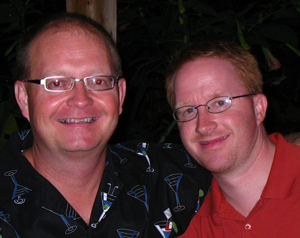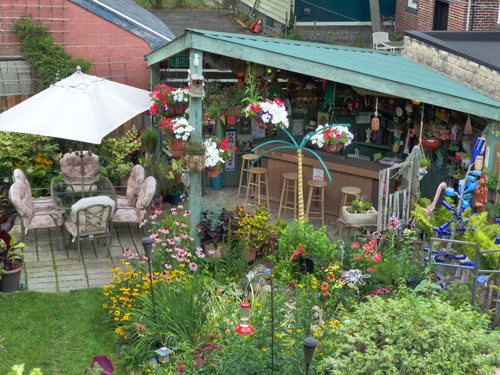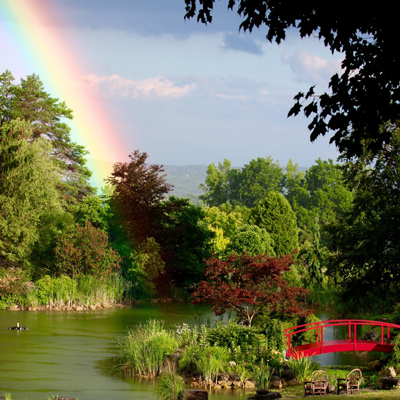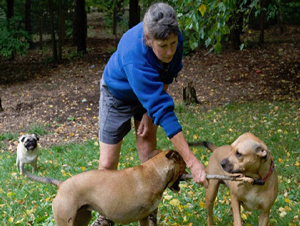by Michelle Sutton
I followed up with some of the fascinating people I’ve profiled in UGJ in the past: Gordon Ballard, Nina Bassuk, Sally Jean Cunningham, Karen Hanford, Mary Hirshfeld, and Todd Lighthouse. What are they up to now? How has their gardening life changed? Here they are, in their own words.
GORDON BALLARD
In the ten years that have passed since our story in UGJ, so many things have changed both in our lives and in our gardens. Most importantly, I am happy to say that my partner Brian, then of eight years, is now my husband of two years! (Yes, 18 years total).
Of course, neither of us has slowed down or downsized our gardens. The surprise snowstorm of October 12-13, 2006, changed our entire approach. For starters, as storm-damaged trees had to be removed,we went from being 2/3 shade gardens to having many more full-sun gardens. We had to remove 100 feet of privet hedge that ran the length of the yard, giving us the opportunity to add a wood fence to support vertical plantings. And we decided we wanted the gardens to be spaces we and our guests could more fully inhabit, so we created three distinct outdoor living rooms, complete with a Key West-inspired 15 x 15-foot, steel-roof bar that we call “El Gordo Cantina.”
The original centerpiece, our 3,000 gallon koi pond, is no longer. After 15 years, the liner finally disintegrated four years ago and we chose not to rebuild it. Instead, we created a new flagstone patio and added rock gardens and new garden beds. Something we learned from that koi pond was that a HUGE pond created exponentially more work!
With all of our new gardening spaces, we have concentrated on adding more rare and unusual plants into our collection. We currently have 100-plus daylily and 125-plus hosta varieties. Our gardens are now considered a real showpiece in the WNY community, a place to host bus and garden club tour-goers as well as several large garden parties attended by the “Who’s Who” in the surrounding horticultural community.
I am now celebrating 34 years in the specialty advertising printing business and still am actively involved in the Buffalo Bills Monday Quarterback Club, having served two years as its president in 2008-2009. I also co-chair the advisory council at the Burchfield Penney Art Center. When not dividing perennials, starting seeds, or just getting his hands dirty, my husband Brian stays busy with his IT job and independent computer work.
NINA BASSUK
Cornell Professor Nina Bassuk continues to teach, lecture, conduct original research, and direct the Urban Horticulture Institute that she founded in 1980.
Like all horticulturists, [husband] Peter and I like to try things that may not be considered possible. We put in a high tunnel (unheated hoop house) two years ago and have been trying to grow figs in Ithaca, which is definitely pushing the envelope (we really, really love figs). The trees are bushy and have lots of figs, but the challenge is getting the fruit to ripen; last year they didn’t, but we’re hoping they will this year. Meanwhile we also grew tomatoes in there and in late September, they look like summer tomatoes at their peak, still flowering and fruiting! It’s looking like we may get tomatoes through Thanksgiving. Maybe they’re trying to tell us we need to grow tomatoes and not figs. The high tunnel is a means of extending the growing season on both ends, but also we’ve noticed much less disease and insect pressure on the plants in the tunnel.
We’re always trying things out and some years we kill a lot of plants—that’s ok, that’s one way you learn. Sometimes the stated hardiness for things is just not so; for instance, people will say that hardy rubber tree (Eucommia ulmoides) is only hardy to Zone 7, but we’ve grown it for multiple seasons in Zone 5 in our landscape.
We love to go to specialty nurseries and we’re always trying new cultivars. At the Brooklyn Botanical Garden we saw a mimosa tree with purple-brown leaves, Albizia julibrissin ‘Chocolate’ and decided to try one even though it’s not hardy—so it gets moved into the garage in the winter. We have lots of plants we bring in and out of the greenhouse, like grapefruit, oranges, and lime trees. Someone was cleaning out their lotus pond and gave us some roots; we tried throwing a brick with a lotus root attached into our small pond, and now we have extraordinarily beautiful lotus flowers and leaves. We also have phragmites grass that we’ll have to dig out. I’m very sorry I planted false spirea (Sorbaria sorbifolia), as it comes up everywhere. You make mistakes but you just keep learning and working at it.
SALLY JEAN CUNNINGHAM
Where am I now? For me there’s been an arc with some change, some of it painful, and some great new things entered my life—a husband and new jobs. But my core definition has remained the same: I’m a writer, a teacher, and a gardener. I just express some of it differently.
When you interviewed me about a decade ago, I was still reeling from losing my position as an Erie County Cornell Cooperative Extension agent, after fourteen years there. It was just like a divorce. I loved the Master Gardeners (still do), and love the Roycroft Campus in East Aurora where CCE Erie is housed. Like the divorced woman seeing her old house, I couldn’t even enter the building. But change is a catalyst for new opportunities. I went to work for a great garden center called Lockwood’s Greenhouses, became an official CNLP (Certified Nursery & Landscape Professional), began to write for The Buffalo News and Buffalo Spree Magazine, stayed on WIVBTV (Channel 4), and kept on giving talks and selling my book Great Garden Companions. I kept spinning those plates in the air for several years, and then a larger commitment called to me.
Whatever the profession, there is a time to give back. At some point I’d worked with so many people on so many projects that I felt connected to all the players
in the regional garden and landscape industry. Garden Walk Buffalo was making our region famous, and our wonderful visitor’s bureau (Visit Buffalo Niagara) asked me to join with the Garden Walk Buffalo leader Jim Charlier to pull everyone in horticulture together and form the National Garden Festival. I directed the project but it was a team effort that included all the garden walks, our landscape industry (PlantWNY) doing amazing beautification projects, great gardeners who created the Open Garden program, our Olmsted Parks and Botanical Garden, and motorcoach tours with AAA to showcase gardens all over the region.
Through the National Garden Festival we increased tourism, raised the performance of every component, and brought even more national attention to our gardening scene. We received an International Garden Tourism award. Garden Walk Buffalo became the largest garden tourism event in the country. New York State’s landscape association and Plant WNY honored me—wow—as person of the year. And AAA asked me to develop Great Garden Travel so that now I can take people to see gardens in America and Europe. I’m still lecturing and teaching, but now some of it is on a motorcoach or airplane!
I’ll be seventy in a couple of years, so I’m accelerating that “giving back” part quickly. Collaborating with Garden Walk Buffalo (now Gardens Buffalo Niagara) and Visit Buffalo Niagara, I pitched Buffalo as the 2017 host (next August) for the Garden Writers Association to come here. We’ll be dazzling hundreds of garden writers, bloggers, and other “garden communicators” with our green and flowering region. Meanwhile I’m excited to be the AAA Great Garden Travel Tour Director and plan to take people to the Philadelphia Flower Show, to England in May, Newport in June, Ireland in late summer, and lots more of that. (See AAA, GreatGardenTravel.com and give them your e-mail or call 1-800-242-4244. Let’s take a trip together!)
I still do some garden consulting and give garden talks. The most important topic to me is nature-friendly landscaping—helping pollinators and using native plants—that is my mission. And I must stop the clock, write the next book, and remember to share time with my family, friends, and dear pets.
So you asked about my gardening? Hah. No time for that companion vegetable garden now, but I have a casual landscape for the birds, insects, and other animals, with massive shrub and flower beds and fine trees. Gardening still centers me. Yes, there’s been change. But if you ask me again in ten years, I believe life will still be about writing, teaching, and gardening.
KAREN HANFORD
Each year we open Sycamore Hill Gardens as a free venue for various local not-for-profits and help them raise funds for their organizations. It’s our way of giving back to the CNY community. We’ve also hosted a few wedding ceremonies and donated those monies to the nearby Baltimore Woods Nature Center, a group dear to our hearts that has held an event here every Mother’s Day for over a decade.
In 2015, to benefit the Onondaga County Library System’s Read One Book program, we hit upon the idea of Weekday Garden Rambles. These are low-key events with 30 to 35 guests, a catered lunch, and a lot of time to ramble the gardens or traverse them on golf cart tours. These fundraisers were very successful, with minimal expense to the Library System. Since then, we’ve decided to do some Rambles of our own as a way to accommodate out-of-town groups. We also have begun to attend independent garden center trade shows and are giving thought to using our century-old barn as a gift shop or perhaps a meeting facility with local restaurant catering.
These plans do affect how we now approach our gardening. For example, to improve the view for our lunching Ramblers, we are starting more perennials and concentrating them in the beds closest to the patio lunch areas, as well as in the areas nearest to the house and barn, including the formal garden. Also, throughout the gardens we are removing spent shrubs and catering more to the needs of the 500 or so varieties of conifers and deciduous trees we’ve planted over the past 25 years.
In August of 2017, Sycamore Hill Gardens will help to host the American Conifer Society’s annual meeting. Spurred on by this deadline, we are well underway in creating a garden to showcase our Asian statuary and pottery in a former pond area. This is an ambitious project involving the construction of a dry waterfall and streambed as well as several islands in a gravel lake. A cut stone wall topped by the addition of a sunken path lined with dwarf conifers will give guests a close-up view of various small specimens without the need to clamber into beds.
Other current sources of horticulture excitement include putting the majority of our former dairy farm into the USDA Conservation Reserve Program by planting 10,000 native trees, 10,000 native shrubs, and 150-plus acres of ground nesting bird meadow mix. This project took three years of our energy, thought, and garden budget, but the increase in birdlife and decrease in soil erosion has made it worth all the time and effort. We’ve also returned to beekeeping, and we’ve returned to vegetable gardening with renewed enthusiasm and a greater emphasis on soil preparation, composting, and organic, non-GMO seeds. You are what you eat, so if we want to continue to garden well into our dotage, we need to eat the best food we can find—and most of it’s in our garden.
MARY HIRSHFELD
In 2014 Mary retired from her position as director of horticulture at Cornell Plantations. She had worked there for 36 years.
While I was still at Plantations I undertook a yearlong course in dog obedience training, followed by an eight- month internship with a local trainer who I respect very much. He teaches a lot of classes, as well as having private clients. I found the behavior aspect of working with private clients far more interesting than teaching classes. By the time I finished my internship, I also had ten years of working with the behaviorists that cycled through the SPCA, developing and implementing behavioral modification programs for “gray” dogs, meaning those who had issues that emerged during their behavioral evaluation. I worked for the SPCA as a behaviorist and trainer for a year and a half after I left Plantations, before several of us on the behavior and training team were laid off due to budget constraints.
I opened my own training business last July and am now working primarily with clients whose dogs have behavioral issues they would like to modify—those that are aggressive towards other dogs; guard food, toys, space, and owners; have terrible door manners; bite and tear clothing when they meet new people, etc. I really enjoy meeting new people and dogs and the minute I enter their home, I lose myself in the intellectual challenge of sorting out what is going on in this particular dog’s mind and how the owner’s behavior plays into that dynamic. I still have four dogs of my own; all are shelter dogs except the pug, Lloyd.
TODD LIGHTHOUSE
A whole lot has changed for both my family and business (you can see the original story about Todd here). Our family has gotten bigger. My wife Andrea and I have had two more children, Kate (4) and Lauren (2 months), in addition to our son Jack (8). We quickly grew out of our backyard greenhouse and bought some land in Lima on 15A just north of the village in 2013 where we built a large pole barn, four more greenhouses, a retail farm stand, and a large market garden employing up to seven people during the busy season.
Organic herb and vegetable transplants for home gardeners are still the cornerstone of our business, though we are coming full circle back to ornamentals. We now grow over 500 herb, vegetable, ornamental annual, perennial, fruit, and succulent varieties and offer about 75 of these to wholesale customers in our custom printed pots under our “The Living Earth” brand.
Our commitment to sustainable growing has continued to develop, as we became Certified Organic through NOFA-NY in 2011. We still make our organic compost-based potting soil, which we now sell through retail outlets under our “The Living Earth” brand. We supply dozens of organic farmers, garden centers, and natural food stores in our area, including the Wegmans Organic Farm in Canandaigua.
Our approach to growing is fundamentally the same: We embrace all life and trust the wisdom of nature in our growing processes. We provide our plants with the best growing conditions as possible so that they can better defend themselves. We’ve expanded heavily into growing produce at our new farm and will be building our first high tunnel later this year to extend our season. Growing organic produce for market has catapulted my interest in the soil web of life to almost an obsession. The “Farmer To Farmer” podcast as well as newly published books by young organic farmers inspired by Eliot Coleman has sent me down an organic farming rabbit hole I didn’t know existed.
Michelle Sutton (michellejudysutton.com) is a horticulturist, writer, and editor.
Views: 30











